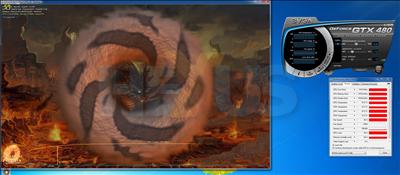Overclocking
With the card installed, we fire it up and see what additional overclocking headroom the GTX 480 now has to offer.
As a reminder, the card's default clocks are 700MHz, 1,400MHz and 3,698MHz for core, shader and memory, respectively. With a card equipped with NVIDIA's reference air cooler and the fan running at ear-piercing levels, we were able to hit 800MHz, 1,600MHz and 4,224MHz, representing a 14 per cent increase over stock.
Using EVGA's Precision utility, we find there's plenty more on offer when liquid cooling comes into play:
Pushing the card as far as we could, we hit 815MHz for the core, 1,630MHz for the shaders and an effective 4,300MHz for the 1,536MB of GDDR5 memory. That's more than a 16 per cent increase over stock for both core and memory.
Raising the memory clocks any further was enough to introduce visual artifacts, whilst pushing the GPU past 820MHz was enough to cause system instability.
A healthy overclock nonetheless, so let's see how that 16 per cent increase translates to real-world performance.










